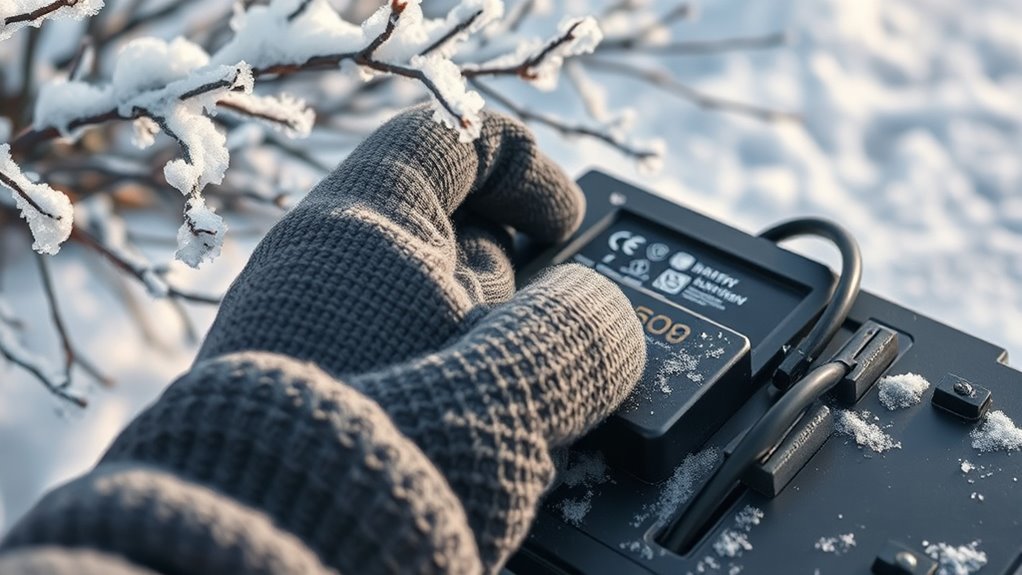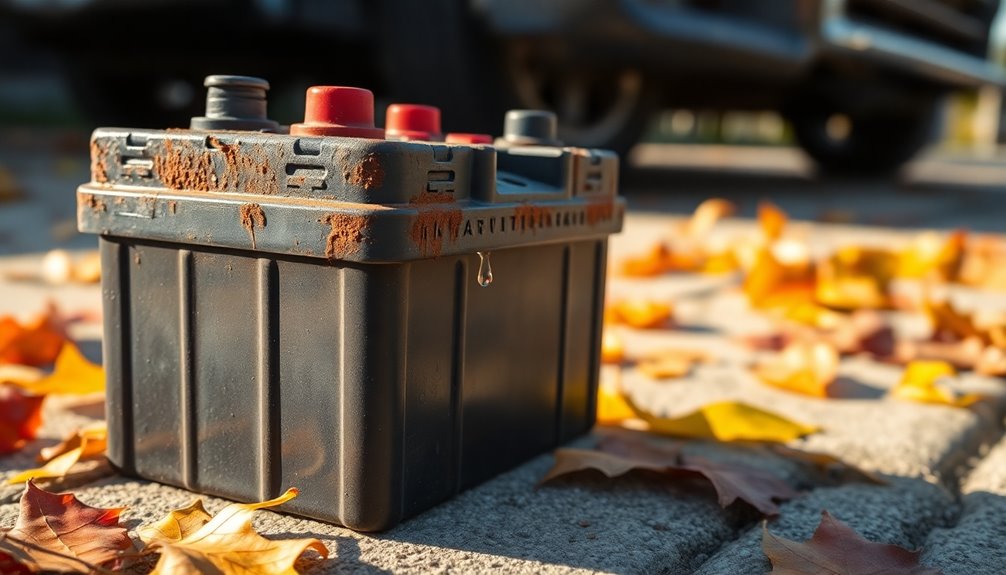To safeguard your battery in winter, start by checking its age and replacing it if over 3-5 years old. Keep it fully charged and clean corrosion from terminals to guarantee good connections. Park in a garage or sheltered area to shield it from extreme cold. Consider using a trickle charger during inactivity and ensure your electrical system is working properly. Proper maintenance now helps prevent cold-weather starting issues—you’ll find even more tips to stay safe in icy conditions.
Key Takeaways
- Regularly test and replace batteries over 3-5 years old to prevent failure in cold temperatures.
- Keep the battery fully charged and use a trickle charger during periods of inactivity.
- Clean corrosion from terminals and ensure they are tightly secured for optimal connection.
- Park your vehicle in a garage or sheltered area to shield the battery from extreme cold.
- Maintain proper tire pressure and consider winter tires for better traction and vehicle safety.

Are you prepared to face the cold weather ahead? Winter can be tough on your vehicle, especially when it comes to keeping your battery and tires in top shape. Cold temperatures drain battery power faster, making it more likely you’ll face starting issues on chilly mornings. To prevent this, focus on proper battery maintenance. Start by checking your battery’s age and condition. If it’s more than three to five years old, consider having it tested or replaced before the cold hits. Clean any corrosion from the terminals and confirm connections are tight; corrosion can hinder the flow of electricity, leaving you stranded. Keep your battery fully charged, as a weak or partially discharged battery struggles even more in low temperatures. If your vehicle has a trickle charger or battery maintainer, use it to keep the charge steady during long periods of inactivity. Also, park your car in a garage or sheltered area whenever possible. This helps shield the battery from extreme cold, reducing the chances of it losing its charge or freezing. Additionally, battery longevity can be extended by ensuring your vehicle’s electrical system is functioning properly, which is crucial in cold weather.
Tire traction is another vital aspect to consider. Cold weather causes the rubber in your tires to harden and lose grip, increasing the risk of slipping or hydroplaning. Regularly check your tire tread depth; it should be at least 4/32 of an inch for safe winter driving. If your treads are worn down, replace them to guarantee better traction. Keep your tires properly inflated because under-inflated tires have less contact with the road, reducing traction and increasing the chance of slipping. Remember, cold air causes tire pressure to drop, so check and adjust the inflation levels regularly. Driving on properly inflated tires with good tread provides better control on icy or snowy roads. Additionally, consider investing in winter tires if you haven’t already. They are designed to maintain flexibility and grip in cold conditions, offering a significant safety boost.
Combining diligent battery maintenance with attention to tire traction makes a real difference during winter months. A well-maintained battery reduces the risk of unexpected breakdowns, while properly inflated tires with good traction give you confidence on slippery surfaces. Stay proactive about these aspects, especially as temperatures drop, and you’ll navigate winter roads more safely and comfortably. Remember, preparation is key—taking small steps now can prevent major headaches later. By keeping your battery in good shape and ensuring your tires are ready for winter challenges, you’re setting yourself up for a safer driving season, no matter how cold it gets.
Frequently Asked Questions
How Can I Tell if My Battery Is Failing in Winter?
You can tell if your battery is failing in winter by watching for slow engine cranks or dim headlights. Perform a voltage test; if it’s below 12.6 volts, your battery might be weak. Check for signs of battery corrosion around terminals, which hampers performance. These signs indicate your battery’s struggling, especially in cold weather, and may require replacement or professional testing to prevent getting stranded.
Are There Specific Batteries Better Suited for Cold Climates?
Yes, you should look for batteries designed for cold climates. Cold climate batteries often use special battery chemistry, like AGM or gel, that performs better in low temperatures. They resist freezing and maintain power more reliably. When choosing, check for labels indicating they’re suited for cold weather, and consult your vehicle’s manual. Investing in a cold climate battery can prevent unexpected failures and ensure your vehicle starts smoothly during winter.
How Often Should I Check My Battery During Winter?
You should check your battery at least once a month during winter to make certain it stays in good condition. Regular battery maintenance and cold weather checks help prevent unexpected failures. Look for corrosion, loose connections, and low charge levels. Cold temperatures can strain your battery, so staying proactive with these checks keeps your vehicle reliable. Don’t wait until it’s too cold or too late—schedule these inspections regularly throughout the season.
Can Cold Weather Damage My Car’s Alternator or Starter?
Cold weather can cause damage to your car’s alternator or starter if you don’t take precautions. The cold increases the strain on your battery, which may lead to alternator issues over time. To prevent this, make sure proper battery insulation and keep an eye on your battery’s health. Regular checks help reduce alternator strain and keep your vehicle running smoothly during winter.
What Are the Signs of a Frozen or Damaged Battery?
Imagine your battery whispering quiet warnings—if you notice sluggish starts or dim headlights, it’s a sign of trouble. Battery corrosion can hide beneath the surface, hinting at impending issues, while a damaged or frozen battery struggles to deliver power. These signs shorten your battery lifespan, so keep an eye out. Regular checks help catch problems early, ensuring your vehicle stays reliable through the cold months ahead.
Conclusion
As winter’s subtle touch whispers its arrival, gentle care for your battery becomes the quiet assurance of reliable performance. By taking simple steps to shield it from the cold, you nurture its longevity and keep your journeys smooth. Embrace these mindful habits, and you’ll find that your vehicle’s heart remains steadfast, even in the chilliest moments. After all, a little attentive warmth can make all the difference in preserving your battery’s quiet strength through the season’s embrace.









